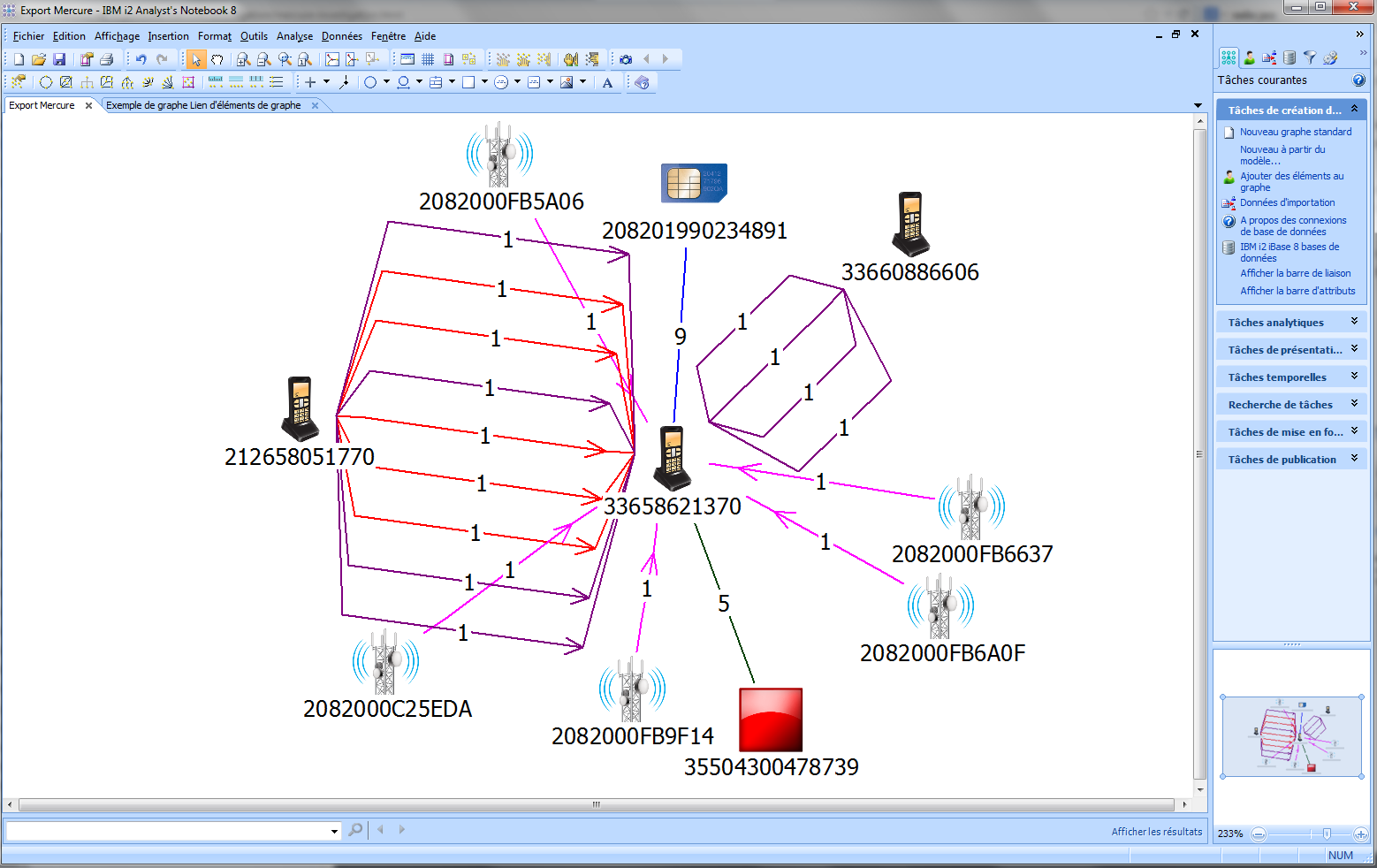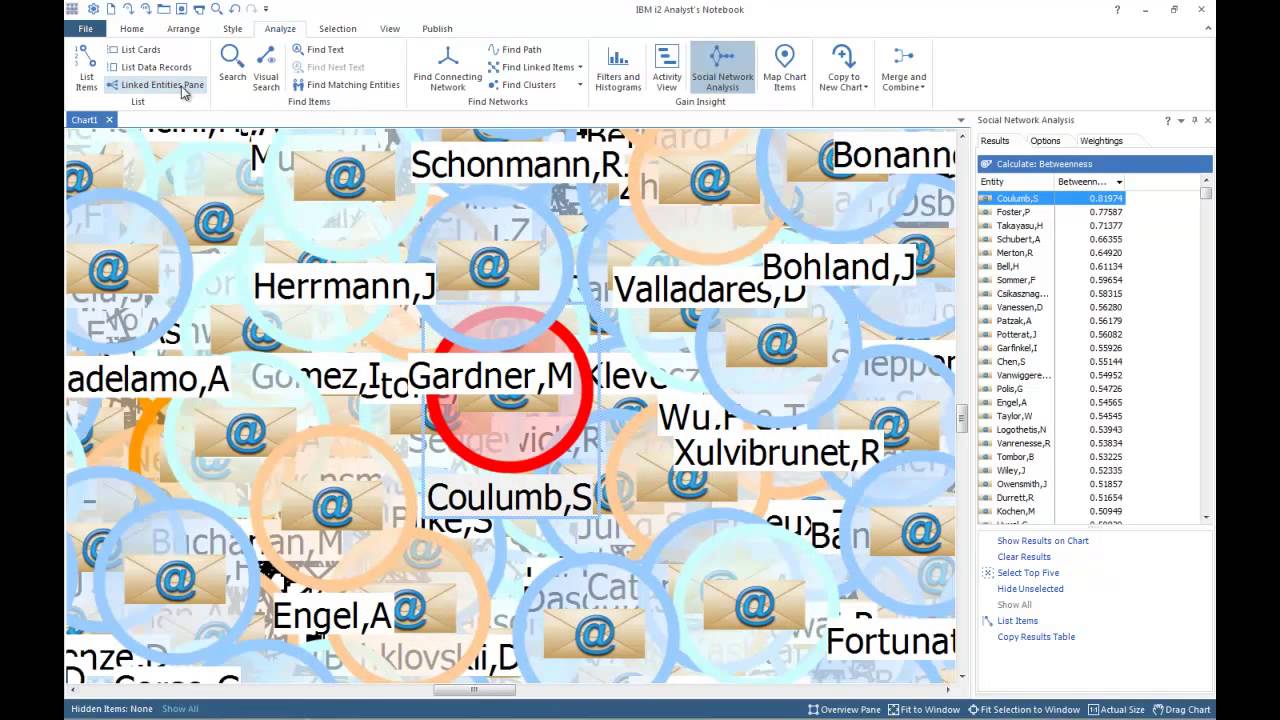

- #IBM I2 ANALYST NOTEBOOK HOW TO#
- #IBM I2 ANALYST NOTEBOOK SERIES#
- #IBM I2 ANALYST NOTEBOOK WINDOWS#
Use Column Action to use different icon types based on Subscriber Type (Gender or Organisation Type). Cleansing Import Data With Column Actions Calculate SNA to identify potential nodes with conditional formatting to find highest Betweenness, Closeness, Degree, Eigenvector, K-Core.Ĥ. Advanced Find Linked & Find Path – adding Bar Charts on entities, links, arrow direction and Date/Time. Using Selection Sets to compare profiles. List Items, Analysis Attributes & Excel. Bar Charts, Histograms & Heat Matrix searches. Visual Search – including analysis attributes. Complex Find Text – using Regular Expressions and Wildcard searches. Create conditional formatting specification to change link width to linear or logarithmic based on link occurrences. Create conditional formatting specification to ignore all non-phone semantic entities and change phone icons to mobile phones if they start with 04, 614 or (04). Create conditional formatting specifications to change icons based on Vehicle Body Style and colour based on Vehicle Colour attributes. Day 1Ĭreate a conditional formatting specification to change all entities based on Attribute Valueĭuplicate and modify a conditional formatting specification to exclude all non-Event semantic entities and change all remaining Event semantic entities based on Label Text Analysis Attributes.Ĭreate a conditional formatting specification to modify link colours based on specific Label Text Analysis Attribute values. Note: Course speed will vary depending on individual’s computer skills, willingness and prior knowledge. Estimated i2 Analyst’s Notebook Analysis & Importing Course Training Schedule #IBM I2 ANALYST NOTEBOOK SERIES#
RevisionĪfter each exercise, the students will be asked a series of questions to reinforce their knowledge. This ensures repetition learnt early can be applied again in different situations, such as using searching functions to modify chart elements to emphasise certain areas of the chart which can aid in visually analysing and briefing from a chart. Visualisation TechniquesĪfter learning the basics involved in creating associative and temporal charts, students will be asked to use functions already taught in subsequent exercises.
#IBM I2 ANALYST NOTEBOOK HOW TO#
These are designed to show how to fix the error or chart the information a different way.

In some cases, the students will be guided towards forcing errors or bad charting practices. The scenarios include multiple entities and links to ensure repetition and thereby reinforce the functionality of i2 Analyst’s Notebook. Step-by-step instructions to obtain the required results. Raw data is provided and students are guided through the process to solve the scenarios with detailed
Q3i2 – IBM9I03G IBM i2 Analyst’s Notebook IntermediateĮxercises in this course are presented using the following elements: Guided Exercises. This course is a prerequisite for the following courses: #IBM I2 ANALYST NOTEBOOK WINDOWS#
Q3i2 – IBM9I02G IBM i2 Analyst’s Notebook Essentials OR IBM i2 Analyst’s Notebook Essentials 9i02G courseĬomfortable using the Windows operating system.īasic understanding of analytical techniques. The prerequisites for taking this course are:
Telecommunications, Insurance, Banking, Retail industry. This course is suitable for the following audiences:  Mapping data to Google Earth with/without virtual paths. Create associative and temporal charts using the Cellebrite import specification. Use Column Actions to cleanse and standardise data when being imported. Create and modify Import Specifications to create associative and temporal charts. Use advanced features of Find Linked and Find Path. Use Regular Expressions, Analytical Attributes and Selection Sets to analyse data. Create and modify Conditional Formatting Specifications. Upon completion of this course, users should be able to: The Searching and Analytical exercises includes using Analytical Attributes and Selection Sets and more advanced features of the Find Linked and Find Path tool. The scenario-driven exercises include example data from open-sourced data sets. Using Google Earth to map chart items with Latitude/Longitude and Date & Time. Modifying Cellebrite data file imports to a summarised associative chart and a temporal chart. Create a variety of Association and Temporal Charts Using the Importer. Import information contained in a Text File. Creating Conditional Formatting Specifications. This course focuses on importing and analysis within Analyst’s Notebook and how to use these two tools together. This course enables users of all levels to understand essential concepts and features required to create and analyse associative and temporal charts. 2-day i2 Analyst’s Notebook Analysis & Importing Course
Mapping data to Google Earth with/without virtual paths. Create associative and temporal charts using the Cellebrite import specification. Use Column Actions to cleanse and standardise data when being imported. Create and modify Import Specifications to create associative and temporal charts. Use advanced features of Find Linked and Find Path. Use Regular Expressions, Analytical Attributes and Selection Sets to analyse data. Create and modify Conditional Formatting Specifications. Upon completion of this course, users should be able to: The Searching and Analytical exercises includes using Analytical Attributes and Selection Sets and more advanced features of the Find Linked and Find Path tool. The scenario-driven exercises include example data from open-sourced data sets. Using Google Earth to map chart items with Latitude/Longitude and Date & Time. Modifying Cellebrite data file imports to a summarised associative chart and a temporal chart. Create a variety of Association and Temporal Charts Using the Importer. Import information contained in a Text File. Creating Conditional Formatting Specifications. This course focuses on importing and analysis within Analyst’s Notebook and how to use these two tools together. This course enables users of all levels to understand essential concepts and features required to create and analyse associative and temporal charts. 2-day i2 Analyst’s Notebook Analysis & Importing Course







 0 kommentar(er)
0 kommentar(er)
